List of stumbling blocks in Carinthia
The list of stumbling blocks in Carinthia contains the stumbling blocks in the Austrian state of Carinthia . Stumbling blocks remind of the fate of the people who were murdered, deported, expelled or driven to suicide by the National Socialists . The stumbling blocks were designed and laid by Gunter Demnig . As a rule, they are in front of the victim's last self-chosen place of residence.
As of August 2018, only stones have been laid in the provincial capital of Klagenfurt in Carinthia, a total of 40 stones for 39 people, two stumbling blocks for Anton Fall , one in German and one in his native Slovene.
Victim groups
The Stolpersteine in Carinthia are dedicated to three groups of victims:
- Jews are said to have lived in the Klagenfurt area, in Judendorf in the 12th century, when Klagenfurt was not yet founded. The first documentary evidence comes from the year 1293. When the future Emperor Maximilian I had the Jews expelled from Inner Austria in 1496, the small Jewish community in Carinthia was also affected. With the state constitution of December 21, 1867 , the settlement restrictions were lifted. Some Jewish families slowly settled there. In 1895 a small cemetery was acquired, in 1905 an own prayer house was set up in Platzgasse and in 1923 the Israelitische Kultusgemeinde was founded. The first rabbi was Ignaz Hauser from Mistelbach. In 1934 around 270 Jews lived in Carinthia. This changed dramatically after the so-called annexation of Austria to the Third Reich . Half of the Stolpersteine in Klagenfurt are dedicated to Jewish citizens.

- The second group are all those who were critical of the Hitler dictatorship or who resisted National Socialism . A few flippant remarks about the Nazi regime (in the Trollinger case) or participation in a police action against National Socialists during the so-called prohibition period (in the Lexer case) were enough and life was forfeited. The ranks of resistance members spanned the entire political spectrum, from a representative of the corporate state to socialists and communists. Some groups of the Carinthian Slovenes were also actively involved in the partisan struggle against the Nazi regime. Around a quarter of the Stolpersteine in Klagenfurt are dedicated to resistance fighters.
- The third group represents the victims of the murders of the sick in the time of National Socialism . In Carinthia, too, physically and mentally handicapped people were labeled as “ unworthy life ” and the doctors and nursing staff were given carte blanche to murder this population group. What began in Germany with the T4 campaign and child euthanasia was seamlessly continued in occupied and annexed areas. Nine of the Klagenfurt Stolpersteine are dedicated to victims of the murders. Eight of the nine victims were deported from the Josefinum in St. Martin, a church nursing home for disabled people, and murdered in the gas chamber of the Hartheim killing center . On July 7, 1941, the last transport of deaths left Carinthia with a total of 111 people, including 25 children from Tainach who had lived in the “Josefinum” in Klagenfurt until 1939. In total, at least 733 people with disabilities from Carinthia were murdered by the Nazi regime in 1940 and 1941.
The names of the Carinthian victims of National Socialism are recorded on the monument to the names in Villach.
Klagenfurt
The following stumbling blocks were laid in the state capital of Klagenfurt am Wörthersee :
Some of the tables can be sorted; the basic sorting is done alphabetically according to the family name.
| image | inscription | Location | Life |
|---|---|---|---|
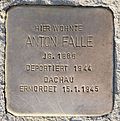 |
ANTON FALLE JG LIVED HERE . 1886 DEPORTED 1944 DACHAU MURDERED January 15th, 1945
TUKAJ JE STANOVAL
ANTON FALLE ROJ. 1886 DEPORTIRAN 1944 DACHAUU UMORJEN January 15, 1945 |
Puntschartstraße / Harbacher Straße (on Harbacher Straße without house number) |
Antonfallen , born on March 25, 1886 in Rajach , was a Carinthian Slovene and spent his youth as a farmhand and later as a construction worker for the Karawankenbahn . He joined the Social Democratic Labor Party of Austria (SDAP), became district party secretary in 1918 and a member of the National Council in 1921. After Florian Gröger's deathin May 1927, he took over the state party chairmanship of SDAP Carinthia and held this function until 1934. After February 12, 1934, Antonfall triedto organizethe resistance against the Austro-Fascist system governmentas a revolutionary socialist , but was arrested, charged and 1935 sentenced to one year in hard prison. His health deteriorated significantly during his detention. Although he refrained fromany visible opposition activityafter the annexation of Austria to the Third Reich , he and numerous other Carinthians were sent to the Dachau concentration camp after the attempted assassination of Adolf Hitler in 1944. He died there on January 15, 1945. |
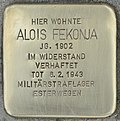
|
ALOIS FEKONJA JG LIVED HERE . 1902 ARRESTED IN THE RESISTANCE DEAD 6.2.1943 MILITARY CRIME CAMP ESTERWEGEN |
Perlengasse 32 |
Alois Fekonja , born in 1902, was a communist who was already politically active during the period of Austrofascism . He was married and had four children. Imprisoned for 12 months in 1938 for distributing leaflets. After serving in the Wehrmacht, arrested again in 1942 and sentenced to two years in prison. He was deported to the Esterwegen concentration camp , a moor camp in which mainly communists and socialists were killed through hard labor, hunger and torture. Fekonja died after severe abuse on February 6, 1943. |

|
HERE LIVED
Siegmund FORESTRY JG. DEPORTED 1878 MURDERED 08/16/1943 AUSCHWITZ |
Karfreitstrasse 5 |
Siegmund Forst , also Sigmund, was born on June 5, 1878 in Klagenfurt. His parents, Heinrich Forst and Fanny geb. Stern, both came from Gross-Becskerek in Vojvodina . They had lived at Kasernengasse 5 in Klagenfurt since 1873. During the reign of the National Socialists, Siegmund Forst stayed in Düsseldorf . He was arrested, deported to the Auschwitz concentration camp and murdered there on August 16, 1943. |

|
MARIE HAUSER JG WORKED HERE . 1884 DEPORTED 09/10/1942 THERESIENSTADT MURDERED 01/23/1943 AUSCHWITZ |
Old place 6 |
Marie Hauser , born on February 19, 1884 in Golta , was a dentist in Klagenfurt. Her husband was a rabbi. After the National Socialists came to power, the family was expelled to Vienna. Her husband and eldest son were able to emigrate to the USA, son Friedrich to Palestine. Marie Hauser was deported to the Theresienstadt ghetto on September 10, 1942 and murdered in Auschwitz on January 23, 1943. |
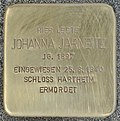
|
JOHANNA JARNEITZ JG LIVED HERE . 1897 ASSIGNED 25.8.1940 HARTHEIM CASTLE MURDERED |
Josefinumstrasse |
Johanna Jarneitz was one of those disabled people who lived and were cared for in the Josefinum care home in St. Martin. She was born in 1897, admitted on August 25, 1940 and murdered in the Hartheim killing center . |
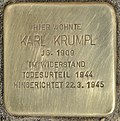
|
HERE LIVED
KARL krumpl JG. 1909 EXECUTED IN THE RESISTANCE DEATH JUDGMENT 1944 March 22, 1945 |
Last Street 3 |
Karl Krumpl was born in 1909. He was typesetter in the Carinthia printing works and secretary of the Fatherland Front . During the corporate state he was from 1934 to 1938 member of the state parliament in the professional state parliament for the profession of trade. He was arrested by the Nazi regime in 1938 and remained imprisoned until 1941. In 1942 he joined the “Antifascist Freedom Movement in Austria”. He was drafted into military service and joined a penal company, first stationed in Belgium, Holland and France, and finally in 1943 with theAfrica Corps in Tunis. In 1943 he was arrested again, sentenced to deathas a member of a resistance group by the People's Court in 1944andexecutedby guillotine a few weeks before the end of the war, on March 22, 1945, in the Vienna Regional Court. |

|
ALOIS LACKNER JG LIVED HERE . 1913 ASSIGNED 07/07/1941 HARTHEIM CASTLE MURDERED |
Josefinumstrasse |
Alois Lackner was one of those disabled people who lived and were cared for in the Josefinum care home in St. Martin. He was born in 1913, admitted on July 7, 1941 and murdered in the Hartheim killing center . |
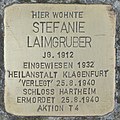
|
STEFANIE LAIMGRUBER JG LIVED HERE . 1912 DISTRIBUTED 1932 KLAGENFURT HOSPITALITY 'RELOCATED' 08/25/1940 HARTHEIM CASTLE MURDERED 08/25/1940 ACTION T4 |
Bahnhofstrasse 44 |
Stefanie Laimgruber , born in 1912, suffered from a schizophrenic illness. She was admitted to the psychiatry in Klagenfurt in 1932 and transferred to the Hartheim killing center on August 25, 1940 , where she was murdered on the same day. |

|
GEORG LEXER JG LIVED HERE . DEPORTED 1888 1938 BUCHENWALD MURDERED 3.8.1941 |
Bahnweg 21 |
Georg Lexer , born on October 20, 1888 in Klagenfurt, was post commander of the gendarmerie in Klagenfurt. He was charged with the death of two July Putschists, but the case was dropped. Nevertheless, he was later taken to the St. Ruprecht police prison by the Gestapo . In 1938 he was deported to Buchenwald concentration camp , where he was shot on August 3, 1941. |

|
EVA LINKER JG LIVED HERE . 1938 ON THE RUN ARRESTED MURDERED 1942 sajmište concentration camp IN BELGRADE |
Gabelsbergerstrasse 22 |
Eva Linker was born in Klagenfurt in 1937 or 1938 as the daughter of Hedwig and Leon Linker. At the end of 1941 she was taken to the Sajmiste concentration camp near Belgrade, where she was murdered by the Nazi regime together with her mother in a gas truck. |

|
HEDWIG LINKER JG LIVED HERE . 1914 ON THE RUN ARRESTED MURDERED 1942 sajmište concentration camp IN BELGRADE |
Gabelsbergerstrasse 22 |
Hedwig Linker (née Czucka) was born on July 3, 1917 in Spittal an der Drau , she came from a merchant family. In 1937 she married Leon Linker from Klagenfurt, and their daughter Eva was born in 1938. At the end of 1939 Hedwig, Leon and Eva Linker tried to get to the Black Sea and from there to Palestine with a Danube steamer. The ship was stopped at Kladovo, the refugees were initially housed with farmers, and in September 1940, still hoping to continue their journey, they were transferred to the small Serbian town of Šabac near Belgrade. After the attack by the Nazi regime on Yugoslavia in April 1941, the refugees were interned, in October 1941 all male inmates were shot, and from March 1942 the women and children were murdered with two gas vans that were specially brought from Germany . 50 to 80 people were gassed every day, including Hedwig Linker with her then four or five year old daughter Eva. |

|
LEON LINKER JG LIVED HERE . 1907 MURDERED ON THE RIGHT TO RETREAT ACTION BY THE GERMAN ARMY SABAC / SERBIA DEAD 12.10.1941 |
Gabelsbergerstrasse 22 |
Leon Linker , born on February 18, 1907 in Siret . The Linker family traded in furs. He married Hedwig, nee Czucka, in 1937. Daughter Eva is born in 1938. In 1938, after the Nazis marched in, Leon and his family fled to Vienna. In November 1939 they succeeded in boarding a Danube ship bound for Palestine in Bratislava. In December the trip ended in Kladovo . The refugees should wait for the ice to melt there. The trip was not continued, however, in September 1940 the refugees were brought to the city of Šabac . After the occupation of Yugoslavia by the Nazi regime in 1941, all of the refugees on the transport were systematically murdered. The men , including Leon Linker, were shot dead in October 1941 as part of a so-called atonement . He died on October 12, 1941. The women and children, including his wife and daughter, were murdered in so-called gas vans from March to May 1942. |

|
HERE LIVED
REGINE 'Rifke' LEFT JG. 1871 DEAD ON THE FLIGHT 1.1.1940 VIENNA |
Bäckergasse 10 |
Regine Linker (née Berger) was born in Siret in Bukovina in 1871 . She was married to Samuel Linker and had at least two children with him, sons Leon and Mark. The family lived on Bäckergasse in Klagenfurt. In order to prepare for her escape from the Nazi regime, Regine Linker and her husband went to Vienna after the Anschluss. According to the entry of her son Mark in the central database of Holocaust victims in Yad Vashem, she died there in December 1940. Her husband, her son Leon, her daughter-in-law Hedwig and her granddaughter Eva were all murdered by the National Socialists. |
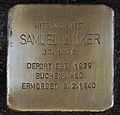
|
SAMUEL LINKER JG LIVED HERE . DEPORTED 1876 1939 BUCHENWALD KZ MURDERED 9.2.1940 |
Bäckergasse 10 |
Samuel Linker was born on January 2nd, 1876 in Storoschynez in northern Bukovina . He married Regine Berger and had at least two sons with her. The family came to Klagenfurt after the First World War and owned a shop on Kardinalsplatz that dealt in raw products and scrap metals. The city of Klagenfurt writes on its website: "The Linkers were a long-established, Jewish family, well-known fur traders." That did not protect them from hostility and defamation, from losing their business, residence and home. The whole family fled to Vienna, where Samuel Linker was arrested, taken to Buchenwald concentration camp and murdered on February 9, 1940. His wife died in Vienna in December 1940, his son Leon was shot by the SS on October 12, 1941, his daughter-in-law Hedwig and his granddaughter Eva were murdered in a gas truck between March and May 1942. |

|
JOSEF LOGAR JG LIVED HERE . ARRESTED 1915 1944 'HIGHLY REPRESENTED' EXECUTED 7.4.1945 KASERNE WETZELSDORF GRAZ |
Villacher Strasse 1 |
Josef Logar , born on August 16, 1915 in Vellach , was a magistrate in the Klagenfurt Army Administration. He is said to have leaked investment plans that were important to the warfare to partisans, was arrested in 1944, sentenced to death for high treason and executed on April 7, 1945 in the Belgian barracks in Graz-Wetztelsdorf. |
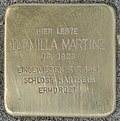
|
LUDMILLA MARTINZ JG LIVED HERE . 1929 DISTRIBUTED 07/07/1941 HARTHEIM CASTLE MURDERED |
Josefinumstrasse |
Ludmilla Martinz was one of those disabled people who lived and were cared for in the Josefinum care home in St. Martin. She was born in 1929, admitted on July 7, 1941 and murdered in the Hartheim killing center . |
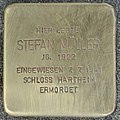
|
STEFAN MÜLLER JG LIVED HERE . 1922 DISTRIBUTED 07/07/1941 HARTHEIM CASTLE MURDERED |
Josefinumstrasse |
Stefan Müller lived in the Josefinum care home for handicapped people and was transferred to Hartheim in July 1941 , where he was murdered. |

|
ALFONS NEUMANN JG LIVED HERE . 1888 DEPORTED BUCHENWALD MURDERED July 22, 1941 |
Wiener Gasse 4 |
Alfons Neumann was born on August 22, 1888 in Klagenfurt. He was the son of Emanuel and Mathilde Neumann, nee Tausig, who owned the house at Wiener Gasse 4 in Klagenfurt. In 1922 he became an Austrian citizen. The Documentation Archive of the Austrian Resistance (DÖW) states Graz as the place of residence and the Buchenwald concentration camp as the destination of the deportation . According to DÖW, he was murdered by the Nazi regime on July 14, 1941, and according to Stolperstein and A Letter To The Stars on July 22, 1941. |

|
EMMANUEL NEUMANN JG LIVED HERE . 1858 DEPORTED 14.7.1942 THERESIENSTADT MURDERED 8.9.1942 |
Wiener Gasse 4 |
Emmanuel Neumann (also Emanuel Neumann) was born on May 12, 1858. He was married to Mathilde Neumann, née Tausig. The couple had a son, Alfons Neumann. In 1887 Emmanuel Neumann took part in the founding of the Kultusverein. In 1899 the family settled in downtown Klagenfurt, where he acquired the house at 4 Wiener Gasse in 1905. After the annexation of Austria by the National Socialists, he and his wife had to leave Klagenfurt. The DÖW lists Vienna 2 as the last place of residence, Große Schiffgasse 3 AH. He was deported to the Theresienstadt ghetto on July 14, 1942, at the age of 84, and murdered there on September 8, 1942 by the Nazi regime. |

|
MATHILDE NEUMANN JG LIVED HERE . 1860 DEPORTED 7/14/1942 THERESIENSTADT MURDERED 10/7/1942 |
Wiener Gasse 4 |
Mathilde Neumann , née Tausig, was born on April 25, 1860. She was married to Emmanuel Neumann and had to flee to Vienna after the annexation of Austria in 1938. She and her husband were deported from Vienna to the Theresienstadt ghetto on July 14, 1942 . Mathilde Neumann was murdered by the Nazi regime on October 7, 1942. |

|
HERE LIVED
ELEONORE 'ELA' OSTERMANN JG. DEPORTED 1869 1942 THERESIENSTADT MURDERED 9/23/1942 TREBLINKA |
Sankt-Veiter-Strasse 4 |
Eleonore Ostermann , born March 1, 1869 in Galicia, came from a long-established Jewish family and ran a general store in Klagenfurt, right across from her home address. After the annexation of Austria to the Third Reich , she fled to Vienna. Her last known residence was Grosse Schiffgasse 3 in Leopoldstadt . She was arrested, on July 14, 1942, deported to the Theresienstadt ghetto and from there on September 21, 1942 to the Treblinka extermination camp , where she was murdered.
Eleonore Ostermann must have had at least one child. Because her granddaughter Ester Itzhaki, who reached the age of 86 in 2014, survived the Nazi regime and lived in Israel in 2014. Their son, Ostermann's great-grandson Ron Itzhaki, came to Klagenfurt to lay the Stolperstein. |

|
HERE LIVED
ELSE 'LISEL' PRICE GEB. SCHNEIDER JG. 1908 DEPORTED 08/20/1942 THERESIENSTADT MURDERED 05/16/1944 AUSCHWITZ |
Paradeisergasse 4 |
Else Preis was born on April 25, 1908 in St. Johann im Pongau. Her parents owned a tailor's shop and a department store there. On September 17, 1933, she married Felix Preis. The couple had two children: daughter Eva (1935) and son Peter Adolf (1936). After the so-called Reichskristallnacht on November 10, 1938, the couple and their two children fled to Vienna for security reasons, where they applied for an exit permit. This was denied. On August 20, 1942, Else Preis was deported to the Theresienstadt ghetto with her husband and two children, as well as her mother-in-law Hermine Preis . Her husband was murdered here in February 1944, from there she was transferred with her children Eva and Peter Adolf and her mother-in-law to the Auschwitz concentration camp , where they were all murdered on May 16, 1944. Another source indicates that the exact date of death would not be known. |

|
EVA PRICE JG LIVED HERE . 1935 DEPORTED 08/20/1942 THERESIENSTADT MURDERED 05/16/1944 AUSCHWITZ |
Paradeisergasse 4 |
Eva Preis was born on March 22, 1935 in Klagenfurt as the daughter of Else and Felix Preis. She and her family were deported to the Theresienstadt ghetto on August 20, 1942 . Her father Felix was murdered here. Eva Preis was deported with her mother, brother and grandmother to Auschwitz and murdered there on May 16, 1944. |

|
HERE LIVED
AND WORKED FELIX PRICE JG. 1896 DEPORTED 08/20/1942 THERESIENSTADT MURDERED 02/28/1944 |
Paradeisergasse 4 |
Felix Preis was born on September 30, 1896 in Klagenfurt as the son of Adolf and Hermine Preis. He fought voluntarily - like his older brothers Robert and Emil - in the First World War . In June 1917 he was badly wounded and taken prisoner in Italy. He remained permanently disabled due to his war injury. Several clothing stores and workshops belonged to the family business. After the war, Felix Preis took over the management of a clothing store in Klagenfurt. On September 17, 1933, he married Else Schneider, whose parents owned a tailor's shop and a department store in St. Johann im Pongau . Their daughter Eva was born on March 22, 1935 and their son Peter Adolf on June 12, 1936 in Klagenfurt. Robert, Emil and Felix Preis were sent to the Dachau concentration camp , but released a month later. Robert and Emil fled to Italy, survived and returned to Klagenfurt after the fall of the Nazi regime. Felix Preis moved to Vienna with his wife and two children. He applied for an exit permit, but it was refused. The family often changed their apartment, the last address was Vienna 2, Hofenedergasse 6/28. On August 20, 1942, Felix Preis, his wife, his children and his mother were deported from Vienna to the Theresienstadt ghetto on Transport IV / 8 . Felix Preis was murdered there on February 29, 1944 by the Nazi regime. His mother, wife and children were murdered a little later in the Auschwitz concentration camp . |

|
HERMINE PREIS JG LIVED HERE . 1870 DEPORTED July 28, 1942 THERESIENSTADT MURDERED June 8, 1944 AUSCHWITZ |
Dr.-Arthur-Lemisch-Platz 1 |
Hermione Price was born in 1870. In 1892 she married the Carinthian defender and entrepreneur Adolf Preis, with whom she ran a tailor's shop and a men's clothing store. The couple had three sons, Robert, Emil and Felix, and two daughters, Marianne later married: Schiffler and Dora. In November 1938, the shop and apartment were looted and devastated by Nazi troops, and later Aryanized. Hermine Preis was arrested at the age of 72 and deported to the Theresienstadt ghetto together with her son Felix, daughter-in-law Else, and grandchildren Eva and Peter Adolf . On May 15, 1944, she was deported to the Auschwitz concentration camp, where she was murdered by the Nazi regime on June 8, 1944. |

|
HERE LIVED
PETER ADOLF PRICE JG. 1936 DEPORTED 08/20/1942 THERESIENSTADT MURDERED 05/16/1944 AUSCHWITZ |
Paradeisergasse 4 |
Peter Adolf Preis was born on June 12, 1936 in Klagenfurt as the son of Else and Felix Preis. After his father returned from the Dachau concentration camp in December 1938, he moved to Vienna with his parents and sister. His last residential address was 1020 Vienna, Hofenedergasse 6/28. He and his family were deported from Vienna to the Theresienstadt ghetto on August 20, 1942 with Transport IV / 8 under transport number 37/225 . From there, Peter Adolf Preis was deported with his mother, grandmother and sister to Auschwitz on May 16, 1944 , and murdered on the same day. Another source indicates that the exact date of death would not be known. |

|
ERNST SALZBERGER JG LIVED HERE . 1922 DEPORTED FATE UNKNOWN |
Bahnhofstrasse 55 |
Ernst Salzberger was born on August 1, 1922. He lived with his parents Nandor and Mira Salzberger at Bahnhofstrasse 55 in Klagenfurt. From 1927 onwards, the parents had set up a timber business that was called Silvana Production e Commerce des bois in French . After the annexation of Austria by the National Socialist German Reich in 1938, the thriving business was " Aryanized ". The family fled to Bratislava . After the invasion of the German Wehrmacht and the subsequent defeat of Czechoslovakia , Ernst Salzberger was taken to a concentration camp and subsequently murdered. The date of death, place of death and further circumstances are not known. |
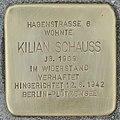
|
KILIAN SCHAUSS JG LIVED HERE . 1909 ARRESTED IN THE RESISTANCE, EXECUTED 12.6.1942 BERLIN-PLÖTZENSEE |
Hagenstrasse 6 |
Kilian Schauss was born on July 7, 1909 in St. Martin am Silberberg . He went to school in Knappenberg and Hüttenberg and became a baker. In 1934 he joined the Communist Party. He attended the International Lenin School in Moscow and became a resistance fighter. From autumn 1938 to spring 1940 he played a major role in the communist resistance in Carinthia, as the successor to Simon Kompein . His battle name was Alfred Bergmann . He probably married in 1940. In the same year he was arrested during a leaflet campaign, brought before the People's Court in Vienna, sentenced to death and executed on June 12, 1943 in Berlin-Plötzensee . |

|
FRANZ SCHORSCH JG LIVED HERE . 1913 ASSIGNED 07/07/1941 HARTHEIM CASTLE MURDERED |
Josefinumstrasse |
Franz Schorsch was one of those disabled people who lived and were cared for in the Josefinum care home in St. Martin. He was born in 1913, admitted on July 7, 1941 and murdered in the Hartheim killing center . |

|
This is where
KARL SCHORSCH JG lived. 1914 ASSIGNED 07/07/1941 HARTHEIM CASTLE MURDERED |
Josefinumstrasse |
Karl Schorsch was one of those disabled people who lived and were cared for in the Josefinum care home in St. Martin. He was born in 1914, admitted on July 7, 1941 and murdered in the Hartheim killing center . |
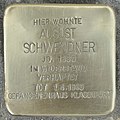
|
AUGUST SCHWENDNER JG LIVED HERE . 1889 IN THE RESISTANCE ARRESTED TOT 01/04/1940 PRISONERS HOUSE KLAGENFURT |
Freiligrathstrasse 7 |
August Schwendner , born in 1889, was a social democratic resistance fighter and fought against the Nazi regime together with his brother-in-law Josef Unteregger . In the spring of 1940 he was arrested for distributing communist leaflets and died on April 1, 1940 in Gestapo detention as a result of torture in the Klagenfurt Regional Court . |

|
JULIE SPITZ JG LIVED HERE . 1902 DEPORTED 1942 MALY TROSTINEC MURDERED June 15, 1942 |
Spengergasse 8 |
Julie Spitz was born on April 26, 1902, to Bernhard and Rosa Spitz. She was a civil servant, married and had a son. After the annexation of Austria to the Third Reich, her husband divorced. She was forced to leave Klagenfurt and had to move into a collective apartment at 6 Kegelgasse in Vienna. She was arrested and deported on June 9, 1942 with Transport 26, Train Da 206 from Vienna to Minsk . She was murdered on June 15, 1942 by the Nazi regime in the Maly Trostinez extermination camp .
Her son Josef escaped with a youth transport and survived the Shoah . |

|
ERNST STEINHAUSER JG LIVED HERE . 1917 ASSIGNED 07/07/1941 HARTHEIM CASTLE MURDERED |
Josefinumstrasse |
Ernst Steinhauser was one of those disabled people who lived and were cared for in the Josefinum care home in St. Martin. He was born in 1917, admitted on July 7, 1941 and murdered in the Hartheim killing center . |

|
KARL STRAUSS JG LIVED HERE . 1896 ARRESTED 1945 DACHAU MURDERED April 15, 1945 |
Perlengasse 30 |
Karl Strauss , born on October 29, 1896 in Portendorf , was a social democrat and belonged to a small resistance group. Gestapo men disguised themselves as partisans, took part in a meeting, evicted the resistance group, abused them and arrested them. Karl Strauss was deported to the Dachau concentration camp . There he died on April 15, 1945 of an untreated typhoid disease at the age of 48. |

|
FRANZ SWOBODA JG WORKED HERE . 1887 DEPORTED 1944 DACHAU MURDERED 6.4.1945 |
Bahnhofstrasse 44 |
Franz Swoboda was born in 1887. He was a committed trade unionist, fought for workers' rights and against child misery. From 1930 to 1934 he was a member of the social democratic state parliament. In 1934 the free trade unions were dissolved, Swoboda continued to strive for the rights of workers and for the dissemination of information in the illegality. In 1944 he was arrested by the Gestapo and deported to the Dachau concentration camp . Less than a month before the end of the war, he died on April 6, 1945 of deprivation and typhus. |

|
WALTER TOLLINGER JG WORKED HERE . 1901 ARRESTED IN 1944 PRISON GRAZ MURDERED December 8th, 1944 |
Old place 31 |
Walter Tollinger , born April 1, 1901 in Klagenfurt , was an artist and photographer. He led a successful photo studio and "was considered a critical spirit, which expressed its opposition to Nazism in public." He was arrested in April 1944 in Klagenfurt, the Higher Regional Court of Graz sentenced to death and on December 8, 1944 in the prison of Graz- Jakomini executed. His wife Berta continued the studio after his arrest. |

|
SUSANNE ZECHNER JG LIVED HERE . 1916 MURDERED 9.6.1943 KLAGENFURT GAUKRANKENHAUS |
Josefinumstrasse |
Susanne Zechner was one of those disabled people who lived and were cared for in the Josefinum nursing home in St. Martin. She was born in 1916 and murdered on June 9, 1943 in the Klagenfurt Gau Hospital . |

|
BERTHA ZEICHNER GEB. LIVED HERE SPITZ JG. 1894 DEPORTED February 19, 1941 KIELCE FATE UNKNOWN |
Adlergasse 14 |
Berta Drawer , nee Spitz, was born on March 4th, 1894 in Tulln on the Danube . On June 26, 1918, she married Moritzzeichner (born March 23, 1888 in Jabluniw in Galicia). The couple had two children: Otto (born 1921) and Erna (born 1922). The family ran a trade in leather and furs in Auergasse. The draftsmen were first driven from their homeland, had to move to Vienna and were separated there. Moritz arrived in Palestine with a transport for men , as did his daughter Erna with a transport for children and young people via Bulgaria. Son Otto went to Holland, but was caught there by the National Socialists , deported to Auschwitz and murdered. Berta Schildner was deported to Kielce on February 19, 1941 , her further fate is unknown. However, she did not survive the Shoah. |

|
OTTO DRAWER JG LIVED HERE . 1921 ESCAPE HOLLAND INTERNS 15.7.1942 WESTERBORK DEPORTED AUSCHWITZ MURDERED 11.8.1942 |
Adlergasse 14 |
Otto Drawer was born on February 19, 1921 in Klagenfurt as the son of Bertha and Moritz Drawer. In the school year 1936/37 he attended the Klagenfurt commercial school . His surviving sister reported: "After graduating from commercial school, my brother attended evening courses at the school." After the annexation of Austria by the Nazi regime , he and his family first had to move to Vienna. However, he went to a Zionist youth camp in Holland. There he was captured by the National Socialists, deported from Westerbork to Auschwitz on July 15, 1942 , and murdered on August 11, 1942. |
Laying data
The Stolpersteine in Klagenfurt am Wörthersee were laid by Gunter Demnig personally on the following days:
- March 25, 2012: Adlergasse 14, Alter Platz 6, Dr.-Arthur-Lemisch-Platz 1, Paradeisergasse 4, Wiener Gasse 4
- 4th July 2014: Alter Platz 31, Bäckergasse 10, Bahnhofstraße 44, Bahnweg 21, Gabelsbergerstraße 22, Perlengasse 30, Puntschartstraße / Harbacher Straße, Sankt-Veiter-Straße 4, Villacher Straße 1
- August 5, 2018: Josefinumstrasse, Hagenstrasse 6, Perlengasse 32, Freiligrathstrasse 7, ladenstrasse 3, Bahnhofstrasse 44, Bahnhofstrasse 55, Spengergasse 8, Karfreitstrasse 5.
Memorial plaque in the country house
In June 2013, the Carinthian Governor Peter Kaiser announced that a memorial plaque would be attached to the Carinthian State Parliament for the six members of the National Council and State Parliament who were murdered by the National Socialists. This plaque also commemorates three victims to whom a stumbling block was dedicated: Antonfallen, Karl Krumpl and Franz Swoboda. The other three victims are Franz Aschgan (1899–1945), Peter Melcher (1878–1945) and Vinko Poljanec (1876–1938), who is said to have died as a result of Gestapo imprisonment. The initiator of the memorial was the local councilor Reinhold Gasper. The plaque was unveiled in May 2014 by LH Peter Kaiser and President Reinhart Rohr .
See also
swell
- Documentation archive of the Austrian resistance : database of victims
- City of Klagenfurt: Stumbling blocks 2012
- City of Klagenfurt: stumbling blocks 2014
- City of Klagenfurt: Stumbling blocks 2018
literature
- Nadja Danglmaier, Werner Koroschitz: National Socialism in Carinthia (= National Socialism in the Austrian federal states. Volume 7). StudienVerlag, Innsbruck / Vienna / Bozen 2016, ISBN 978-3-7065-5244-8 .
- August Walzl: The Jews in Carinthia and the Third Reich. Carinthia University Press, Klagenfurt 1987, ISBN 3-85378-298-1 .
- Vinzenz Jobst: 39 stumbling blocks in Klagenfurt - impulses for local memory work. In: Bulletin of the History Association for Carinthia. 1st half of 2019. Klagenfurt 2019. pp. 103–106.
- Wilhelm Baum , Peter Gstettner , Hans Haider, Vinzenz Jobst, Peter Pirker (eds.): The book of names. The victims of National Socialism in Carinthia. Kitab Verlag, Klagenfurt 2010, ISBN 978-3-902585-53-0 .
Individual evidence
- ↑ From the history of the Jewish communities in the German-speaking area: Klagenfurt / Kärnten (Austria) , accessed on September 15, 2018.
- ↑ Marjan Linasi : The Carinthian Partisans , Hermagoras, Klagenfurt / Celovec / Ljubljana / Laibach / Vienna / Dunaj 2013, ISBN 978-3-7086-0693-4 .
- ↑ Nadja Danglmaier, Helge Stromberger: Places of National Socialist Violence in Klagenfurt , Part 2. Drava, Klagenfurt / Celovec 2009, ISBN 978-3-85435-568-7 , p. 67.
- ^ Wilhelm Baum, Peter Gstettner , Hans Haider, Vinzenz Jobst, Peter Pirker as editors: The book of names. Kitab-Verlag, Klagenfurt 2010, ISBN 978-3-902585-53-0 , p. 270.
- ^ Austrian Parliament : Antonfallen , accessed on April 14, 2016.
- ↑ a b c d e f g City of Klagenfurt: Stolpersteine 2018 , accessed on September 9, 2018.
- ↑ a b c d e Hans Haider: Carinthian Jews. Humiliated, persecuted, expelled, murdered. , accessed on September 22, 2015 (PDF; 1.88 MB).
- ^ City of Klagenfurt: Stolpersteine 2012 , accessed on January 9, 2017.
- ↑ a b c d e f City of Klagenfurt: Stolpersteine 2014 , accessed on January 8, 2018.
- ^ Austria-Forum : Lexer, Georg , accessed on April 14, 2016.
- ↑ Hedwig Linker. (No longer available online.) In: A Letter To The Stars . Archived from the original on October 3, 2015 ; accessed on October 12, 2018 .
- ↑ a b Hans Haider: Fetching from memory into memory , farewell to Hedwig Linker, Leon Linker and Eva Linker, in: kärnöl , October 20, 2007.
- ^ Yad Vashem : Entry Regine Linker , accessed on September 21, 2015.
- ↑ a b c d e f g h reminiscence.at: 11 stumbling blocks - 11 people , accessed on April 14, 2016.
- ^ Documentation archive of the Austrian resistance , accessed on May 22, 2017.
- ↑ Theresienstadt Memorial Book, Prague 2005, ISBN 3-8258-7590-3 .
- ↑ City of Klagenfurt : Stumbling blocks against forgetting ( Memento of the original from April 14, 2016 in the Internet Archive ) Info: The archive link was inserted automatically and has not yet been checked. Please check the original and archive link according to the instructions and then remove this notice. , July 4, 2014, accessed April 14, 2016.
- ↑ August Walzl: The Jews in Carinthia and the Third Reich . Carinthia University Press, pp. 237–239.
- ↑ a b Marina Jamritsch: The book of names: the victims of National Socialism in Carinthia. Kitab, Klagenfurt 2010, ISBN 978-3-902585-53-0 , p. 694.
- ^ Vienna City and State Archives, 48 T 4309/49.
- ^ Julia Köstenberger: Kaderschmiede des Stalinism. LIT Verlag, Münster 2016, ISBN 978-3-643-50666-5 , pp. 362 and 376.
- ↑ Yad Vashem : Julie Spitz , accessed August 9, 2018.
- ^ Documentation archive of the Austrian resistance : Draftsman Berta , accessed on January 8, 2018.
- ↑ Handelsakademie Klagenfurt am Wörthersee : Jewish students of the HAK Klagenfurt, victims of National Socialism , accessed on September 5, 2015.
- ^ Auschwitz-Birkenau State Museum (ed.): Auschwitz death books, Volume 2/3: List of names AZ (reprinted 2012) . De Gruyter, Berlin / Boston 1995, ISBN 3-11-097409-6 , pp. 1389 .
- ↑ Stumbling blocks remind of Nazi victims. In: www.klagenfurt.at. Magistrate of the state capital Klagenfurt, August 5, 2018, accessed on August 8, 2018 .
- ↑ ORF : Memorial plaque for Nazi victims in the state parliament , July 12, 2013.
- ↑ Mein Klagenfurt: Memorial plaque unveiled at Klagenfurt country house , May 2014.
Web links
- Stolpersteine , official Demnig website


